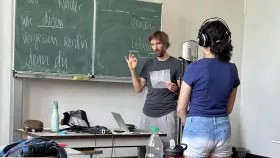Berlin and Mannheim
The Memory Lanes project focuses on two locations in Germany, Berlin and Mannheim. Click below to see what artistic projects the teenagers created in order to retell the stories of Jewish people who once lived in their neighborhoods or keep scrolling to find out more about the Jewish history of these places.
Berlin, Germany
It is home to a thriving Jewish community today, but it has a dark past of marginalization and persecution. In the 19th century, Berlin saw the emergence of liberal Judaism with the Reform Temple and New Synagogue. By 1900, over 110,000 Jews lived in the city. Arts and culture bloomed in the Weimar era but so did antisemitism. When the Nazis rose to power in 1933, they stripped Jews of their rights, and during the ‘November pogrom’ in 1938, hundreds of Jewish shops and synagogues were set ablaze and destroyed. After the Second World War, Berlin was separated into East and West, as were its Jewish communities. Only in 1989, after the fall of the Berlin Wall, were they reunited. In the years that followed, thousands of Jewish immigrants from the former Soviet Union and Israel found new homes in Berlin. Today, Berlin has dozens of memorials that pay respect to its Jewish heritage and the city regularly hosts cultural events to celebrate its present day Jewish life.
Mannheim, Germany
Jewish life in Mannheim began in the 17th century and increased a community of 150 families by the 18th century. A synagogue, Klaus (Jewish house of learning), and Jewish hospital were built in Mannheim during this period. During the 19th century, Jewish industries flourished and Jews held important positions in local governance until 1914. World War I left Jewish commerce weakened, yet it continued. However Nazi rule brought redundancies and attacks on Jewish facilities, which led to an emigration after the November pogrom in 1938. Jewish presence began to grow again after World War II with Eastern European refugees coming to the city. Today, Mannheim has a small but thriving Jewish community.

The project is funded by the Foundation “Remembrance, Responsibility and Future” (EVZ) and the Federal Ministry of Finance (BMF).

